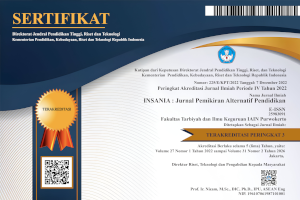Pendidikan Multikultural Dalam Membentuk Karakter Bangsa Melalui Pembelajaran IPS Di Sekolah Confucius Terpadu SD Mulia Bakti Purwokerto Kabupaten Banyumas
Pendidikan Multikultural Dalam Membentuk Karakter Bangsa Melalui Pembelajaran IPS Di Sekolah Confucius Terpadu SD Mulia Bakti Purwokerto Kabupaten Banyumas
DOI:
https://doi.org/10.24090/insania.v22i2.1225Keywords:
Multicultural Education, Character of The Nation, Social SciencesAbstract
The purpose of this study is to find and describe the multicultural education in forming the character of the nation through social sciences learning. The approach considered suitable for this type of research is qualitative. The results of this study obtained some informations, 1) Multicultural education in forming the character of the nation through social sciences learning at Integrated Confucius Elementary School Mulia Bakti Purwokerto has been done by adjusting subject matter of social sciences in each class, from class I to class V associated with multicultural education. 2) Multicultural education in the empowerment of school culture, social structure and education of equal / fair in forming the character of the nation through social sciences learning at Integrated Confucius Elementary School Mulia Bakti Purwokerto has been done by the teachers welcome their students coming every morning, the students shake hands and the teachers fix the students' uniforms and tidy up the hair sometimes. Greetings with smile and polite routinely is always getting used. In school there is no distinction, all students get the same recognition, whether they are Muslim or non-Muslim, they are included in every activity, break fasting togheter, feast day, Chinese New Year, and other activities. 3) Multicultural education can be seen from terms of solidarity, cooperation, tolerance, in forming the character of the nation through social sciences learning. The activity of teacher and student in the classroom as well as in schools is done together so that the differences from religion, tribe, culture are not visible in order to maintain cohesiveness in the classroom. In terms of solidarity, students play like students in other schools, they play without discriminating caused by their origins, they also exchange information about their daily religious activities and the good lessons of their religion.Downloads
References
Banks, James A. 2005. Multicultural Education: Issues And Perspectives, Fifth Edition Update. USA. John Wiley & Sons, Inc.
. 2007. Educating Citizens in a Multicultural Society, Second Edition Update. USA. John Wiley & Son, Inc.
Banks, James A. & Bank, Cherry A. McGee. 2005. Multicultural Education: Issues And Perpectives.USA: John Wiley & Son, Inc.
Choirul Mahfud. 2006. Pendidikan Multikultural. Yogyakarta: Pustaka Pelajar.
Cumming-mc-Cann, Allison. 2003. Multicultural Education Connecting Theory to Practise. Focus on Basic. Volume 6, Issue B. February 2003.
D, Zuchdi. 2010. Pendidikan Karakter dengan Pendekatan Komphrehensif (Terintegrasi Dalam Perkuliahan).
Djahiri dan Ma’mun.1978. Pengjaran Studi Sosial/Ilmu Pengetahuan.Bandung: LPP-IPS-FKIS IKIP.
Gloria Ladson-Billings & Gillborn, David. 2004. The Routledge Falmer Reader in Multicultural education. London & New York: RoutledgeFalmer.
Gorski, Paul C. 2008. Beyond Celebrating Diversity: Exploring The Multicultual Curriculum. Tp.
Gunawan, Rudy. 2011. Pendidikan IPS Filosofi, Konsep dan Aplikasi. Bandung: Alfabeta.
Hanum, Farida dan Setya Raharja. 2007. Pengembangan Model Pembelajaran Multikultural di SD di Provinsi DIY. UNY.
Hamid Hasan. (2010). Pendekatan multikultural untuk penyempuraan kurikulum nasional dapat diakses secara on-line di http://www.pdk.go.id/balitbang/Publikasi/ Jurnal/No_026/pendekatan_hamid_hasan.htm
Hammond, Linda D., French, Jennifer, & Garcia-Lopez, Silvia Paloma. 2002. Learning to Teach for Social Justice. New York: Teachers College Press. Columbia University.
Hasan M.T. 2003. Islam dan masalah sumber daya manusia. Jakarta: Lantabora Press.
Karabel, Jerome & Halsey, A. H. (Ed). 1979. Power and ideology. USA: Oxford University Press, Inc.
Kemendiknas. 2010. Desain Induk Pendidikan Karakter. Jakarta.
Ketchum, Richard M. (ED). 2004. Demokrasi: Sebuah Pengantar. Terj. Yogyakarta: Niagara.
Koesoema A, Dony. 2007. Pendidikan Karakter, Strategi Mendidik Adak di Zaman Global. Jakarta: Grasindo.
Kusmarni, Yani. 2010. Pendidikan Multikultural Suatu Kajian Tentang Pendidikan Alternatif di Indonesia untuk Merekatkan Kembali Nilai-Nilai Persatuan, Kesatuan dan Berbangsa Di Era Global, dapat diakses secara On-line di internet.
Lickona, T. 1991. Educating for Character:How Our Schools Can Teach Respect and Responsibility.New York: Bantam Books.
Luthfiana, Ana Farkhana Laila. 2014. Implementasi Pendidikan Multikultural dalam Pembelajaran IPS di SMP Budi Mulia Dua Yogyakarta. S1 Fakultas Ilmu Sosial.
Megawangi, Ratna. 2004. Pendidikan Karakter Solusi yang Tepat untuk Membangun Bangsa. Jakarta: Star Energy.
Milles, M. B & Huberman, A. M. 2007. Analisis Data Kualitatif. Jakarta: Universitas Indonesia Press.
Moleong, Lexy J. 2009. Metode Penelitian Kualitatif. Ceatakan Kesepuluh Bandung: Remaja Rosdakarya.
Mukminan, dkk. 2002. Diktat Dasar Dasar IPS. Yogyakarta: UNY.
Nazili Shaleh Ahmad. 2011. Pendidikan dan Masyarakat. Yogyakarta: Sabda Media.
Ningsih, Tutuk. 2011. Pendidikan Implementasi Pendidikan Multikultural Pada Pembelajaran Pendidikan Moral. STAIN Purwokerto: Jurnal Penelitian Vol 3 No 2.
Noel, J. 2000. Notable Selection in Multicultural Education. USA: Dushkin. Mc Graw-Hill.
Riant Nugroho. 2008. Pendidikan Indonesia: Harapan, Visi, dan Strategi. Yogyakarta: Pustaka Pelajar.
Samani, Muchlas dan Hariyanto. 2011. Pendidikan Karakter. Bandung: PT Remaja Rosdakarya.
Sutarno. 2008. Pendidikan Multikultural. Jakarta: Direktorat Jendral Pendidikan Tinggi Departemen Pendidikan Nasional.
http://wikipedia.org. Pengertian karakter bangsa diakses pada hari Kamis, 16 Maret 2017 pukul 13.30 WIB.
Zamroni. 2011. Pendidikan Demokrasi pada Masyarakat Multikultural.Yogyakarta: Surya Sarana Grafika.
. 2007. Pendidikan dan Demokrasi dalam Transisi. Jakarta: PSAP Muhammadiyah
Downloads
Published
How to Cite
Issue
Section
License
Authors who publish with this journal agree to the following terms:
Authors retain copyright and grant the journal right of first publication with the work simultaneously licensed under a Creative CommonsAttribution-ShareAlike License that allows others to share the work with an acknowledgment of the work's authorship and initial publication in this journal.
Authors are able to enter into separate, additional contractual arrangements for the non-exclusive distribution of the journal's published version of the work (e.g., post it to an institutional repository or publish it in a book), with an acknowledgment of its initial publication in this journal.
Authors are permitted and encouraged to post their work online (e.g., in institutional repositories or on their website) prior to and during the submission process, as it can lead to productive exchanges, as well as earlier and greater citation of published work (See The Effect of Open Access).








